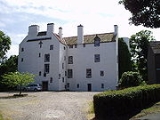
Rossend Castle
Encyclopedia

Burntisland
Burntisland is a town and former royal burgh in Fife, Scotland on the Firth of Forth. According to an estimate taken in 2008, the town has a population of 5,940....
, a town on the south coast of Fife
Fife
Fife is a council area and former county of Scotland. It is situated between the Firth of Tay and the Firth of Forth, with inland boundaries to Perth and Kinross and Clackmannanshire...
, Scotland
Scotland
Scotland is a country that is part of the United Kingdom. Occupying the northern third of the island of Great Britain, it shares a border with England to the south and is bounded by the North Sea to the east, the Atlantic Ocean to the north and west, and the North Channel and Irish Sea to the...
.
A keep
Keep
A keep is a type of fortified tower built within castles during the Middle Ages by European nobility. Scholars have debated the scope of the word keep, but usually consider it to refer to large towers in castles that were fortified residences, used as a refuge of last resort should the rest of the...
, known as the Tower of Kingorne Wester, was in existence on the site from 1119. It was later referred to as Burntisland Castle, and by 1382 was called Abbot's Hall, as it was the home of the Abbot of Dunfermline
Abbot of Dunfermline
The Prior, then Abbot and then Commendator of Dunfermline was the head of the Benedictine monastic community of Dunfermline Abbey, Fife, Scotland. The abbey itself was founded in 1128 by King David I of Scotland, but was of earlier origin. King Máel Coluim mac Donnchada had founded a church there...
. The present building is largely of the 16th century, though with a 13th-century basement, which contains lancet window
Lancet window
A lancet window is a tall narrow window with a pointed arch at its top. It acquired the "lancet" name from its resemblance to a lance. Instances of this architectural motif are most often found in Gothic and ecclesiastical structures, where they are often placed singly or in pairs.The motif first...
s and may represent the remains of a chapel. It was rebuilt by Peter Durie of Durie from 1552, and the arms
Coat of arms
A coat of arms is a unique heraldic design on a shield or escutcheon or on a surcoat or tabard used to cover and protect armour and to identify the wearer. Thus the term is often stated as "coat-armour", because it was anciently displayed on the front of a coat of cloth...
of Abbot George Durie
George Durie
George Durie [Dury confused by Watt & Shead with Drury] , abbot of Dunfermline and archdeacon of St Andrews, son of John Durie of Durie in the county of Fife, and brother to Andrew Durie, bishop of Galloway, was born about 1496. From 1527 till 1530 he acted as judge and executor of the monastery of...
, and the date 1554, appear over the main door. Mary, Queen of Scots, visited during her short personal reign (1561–1567). On 14 February 1562, the French messenger and poet Chastelard
Pierre de Bocosel de Chastelard
Pierre de Bocosel de Chastelard , French poet, was born in Dauphiné; a scion of the house of Bayard, grandson of Chevalier de Bayard. His name is inseparably connected with Mary, Queen of Scots, for whom he conceived an insane passion....
was discovered hiding under Mary's bed in the castle. In 1651 it was captured by the soldiers of Oliver Cromwell
Oliver Cromwell
Oliver Cromwell was an English military and political leader who overthrew the English monarchy and temporarily turned England into a republican Commonwealth, and served as Lord Protector of England, Scotland, and Ireland....
, and in the later 17th century it was owned by the Wemyss family, who remodelled the top floor.
By 1765, it was owned by Murdoch Campbell, a Highlander from Skye
Skye
Skye or the Isle of Skye is the largest and most northerly island in the Inner Hebrides of Scotland. The island's peninsulas radiate out from a mountainous centre dominated by the Cuillin hills...
, who probably gave the building its current name. The castle was acquired by the Town Council in 1952. In 1957, an early 17th-century painted timber ceiling
Scottish Renaissance painted ceilings
A number of Scottish houses and castles built between 1540 and 1640 have painted ceilings. This is a distinctive national style, though there is common ground with similar work elsewhere, especially in France, Spain and Scandinavia. Most surviving examples are painted simply on the boards and...
was discovered; it is now in the National Museum of Scotland
National Museum of Scotland
The National Museum of Scotland, Edinburgh, Scotland, was formed in 2006 with the merger of the Museum of Scotland, with collections relating to Scottish antiquities, culture and history, and the Royal Museum next door, with collections covering science and technology, natural history, and world...
in Edinburgh. The ceiling includes the initials 'SRM' for 'Sir Robert Melville of Murdocairney' and emblems
Emblem book
Emblem books are a category of mainly didactic illustrated book printed in Europe during the 16th and 17th centuries, typically containing a number of emblematic images with explanatory text....
copied from the Devices Heroïques of Claude Paradin. The council threatened to demolish the property, which had been allowed to deteriorate, but it was saved after a public inquiry
Public inquiry
A Tribunal of Inquiry is an official review of events or actions ordered by a government body in Common Law countries such as the United Kingdom, Ireland or Canada. Such a public inquiry differs from a Royal Commission in that a public inquiry accepts evidence and conducts its hearings in a more...
in 1972. It was bought in 1975 by the architecture firm Robert Hurd & Partners, who restored it and retain the building as their offices. It is a category B listed building.

